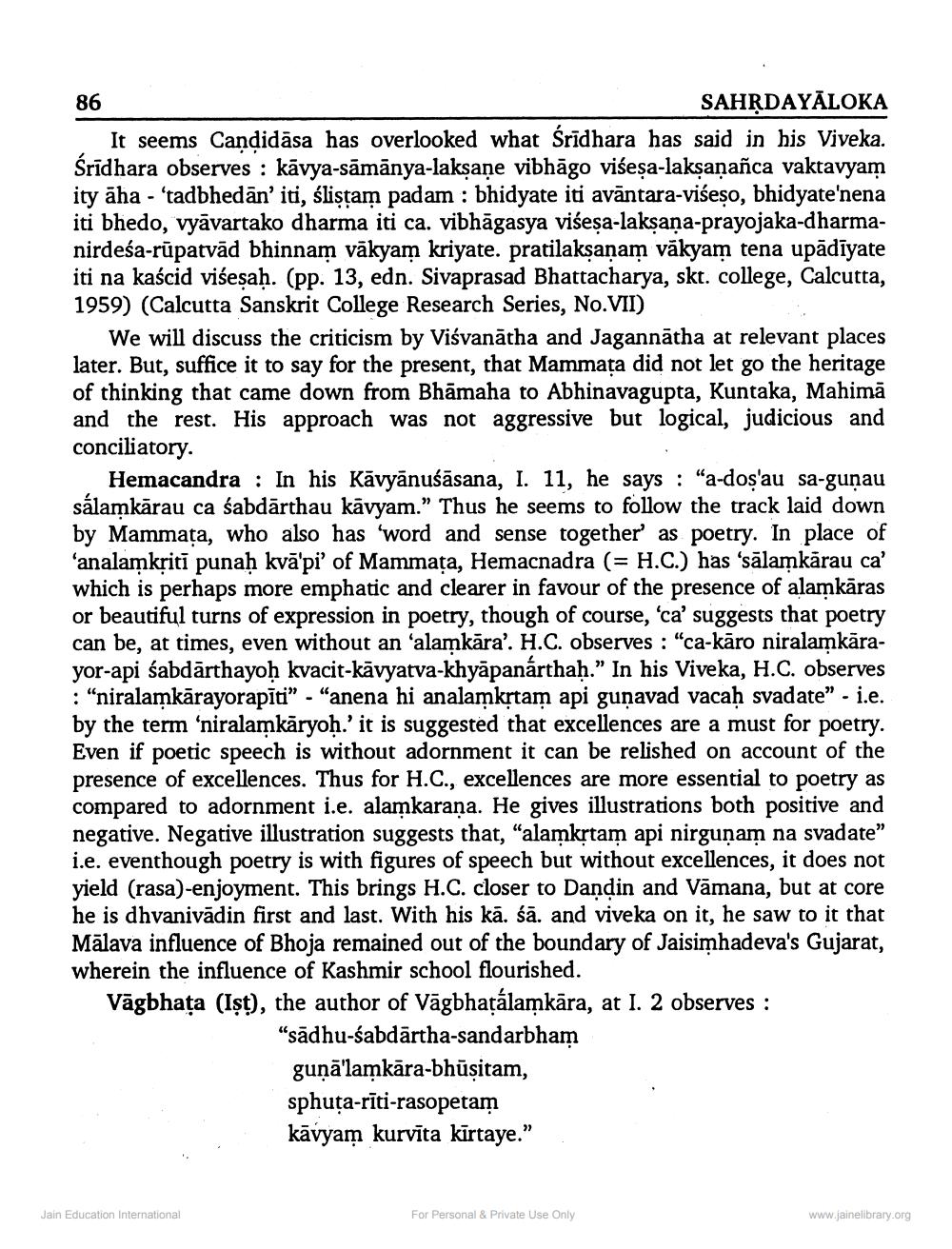________________
86
SAHRDAYĀLOKA It seems Candidāsa has overlooked what Śrīdhara has said in his Viveka. Śrīdhara observes : kāvya-sāmānya-laksane vibhāgo višeșa-laksaņañca vaktavyam ity āha - 'tadbhedān'iti, ślistam padam : bhidyate iti avāntara-viśeso, bhidyate'nena iti bhedo, vyāvartako dharma iti ca. vibhāgasya viśeşa-laksana-prayojaka-dharma
rūpatvād bhinnam vākyam kriyate. pratilaksanam vākyam tena upādīyate iti na kaścid višesah. (pp. 13, edn. Sivaprasad Bhattacharya, skt. college, Calcutta, 1959) (Calcutta Sanskrit College Research Series, No.VII)
We will discuss the criticism by Visvanātha and Jagannātha at relevant places later. But, suffice it to say for the present, that Mammața did not let go the heritage of thinking that came down from Bhāmaha to Abhinavagupta, Kuntaka, Mahimā and the rest. His approach was not aggressive but logical, judicious and conciliatory.
Hemacandra : In his Kāvyānuśāsana, I. 11, he says : "a-dos'au sa-gunau sálamkārau ca sabdārthau kāvyam.” Thus he seems to follow the track laid down by Mammata, who also has 'word and sense together as poetry. In place of 'analamkriti punaḥ kvā'pi' of Mammata, Hemacnadra (= H.C.) has 'sālamkārau ca' which is perhaps more emphatic and clearer in favour of the presence of alamkāras or beautiful turns of expression in poetry, though of course, 'ca' suggests that poetry can be, at times, even without an 'alamkāra'. H.C. observes : "ca-kāro niralamkārayor-api sabdārthayoḥ kvacit-kāvyatva-khyāpanárthaḥ." In his Viveka, H.C. observes : "niralamkārayorapīti" - "anena hi analamkrtam api gunavad vacaḥ svadate" - i.e. by the term ‘niralamkāryoh.' it is suggested that excellences are a must for poetry. Even if poetic speech is without adornment it can be relished on account of the presence of excellences. Thus for H.C., excellences are more essential to poetry as compared to adornment i.e. alamkarana. He gives illustrations both positive and negative. Negative illustration suggests that, "alamkrtam api nirgunam na svadate” i.e. eventhough poetry is with figures of speech but without excellences, it does not yield (rasa) -enjoyment. This brings H.C. closer to Dandin and Vāmana, but at core he is dhvanivādin first and last. With his kā. śā. and viveka on it, he saw to it that Mālava influence of Bhoja remained out of the boundary of Jaisimhadeva's Gujarat, wherein the influence of Kashmir school flourished. Vāgbhața (Ișt), the author of Vāgbhatálamkāra, at I. 2 observes :
"sādhu-sabdārtha-sandarbham
gunā'lamkāra-bhūsitam, sphusa-rīti-rasopetam kāvyam kurvīta kīrtaye.”
Jain Education International
For Personal & Private Use Only
www.jainelibrary.org




